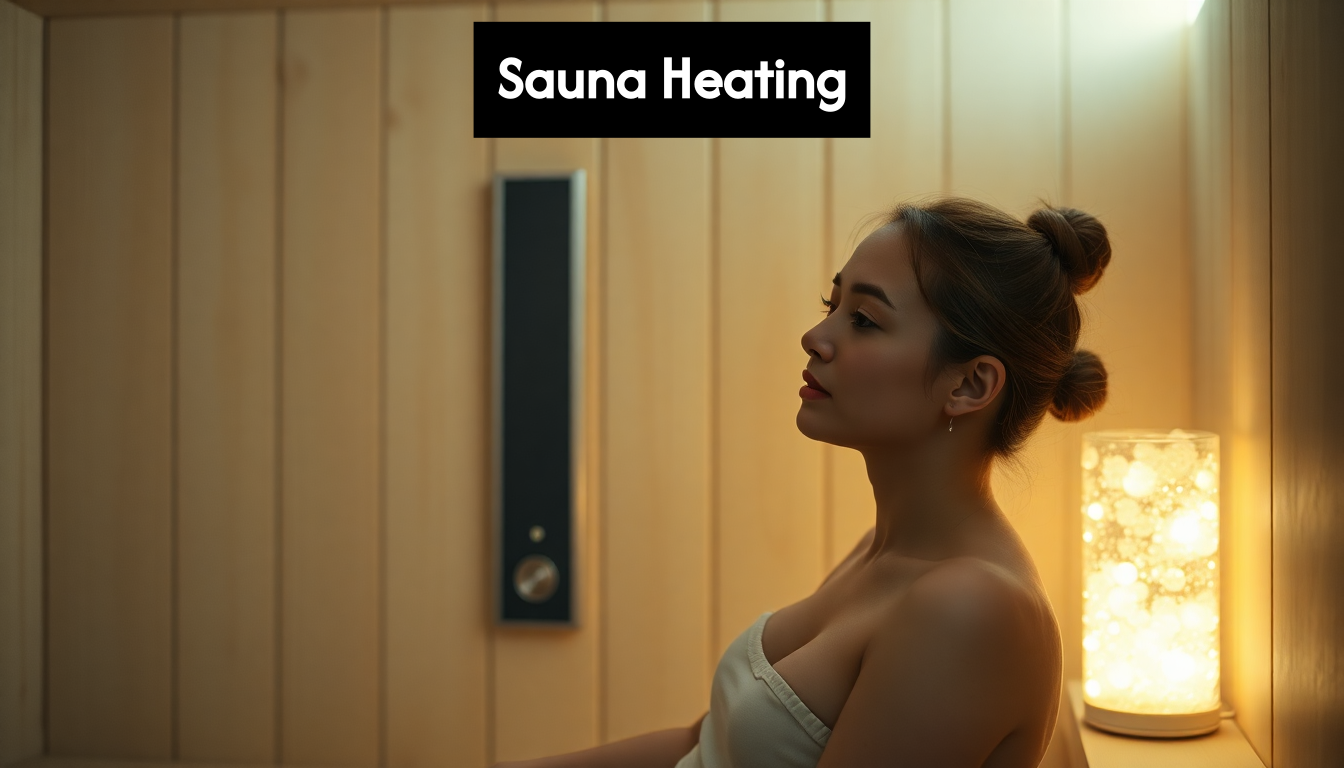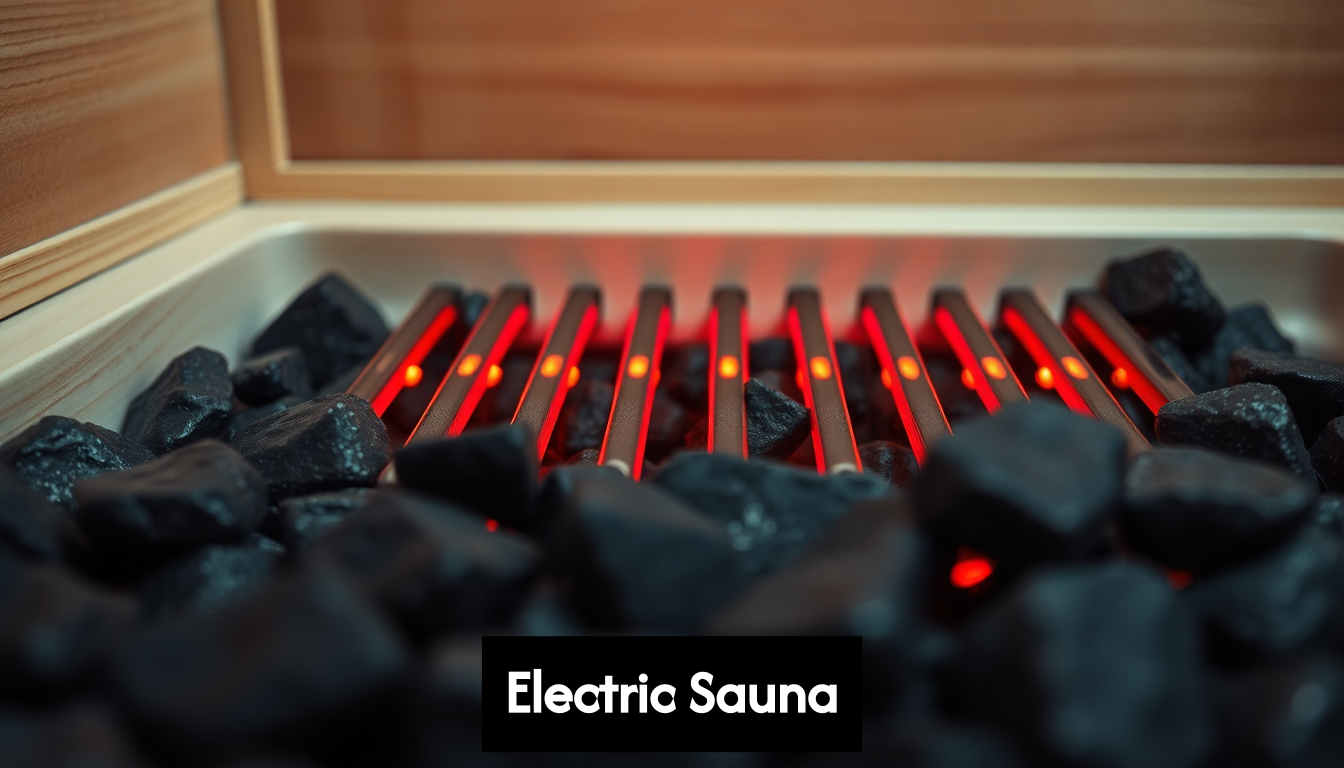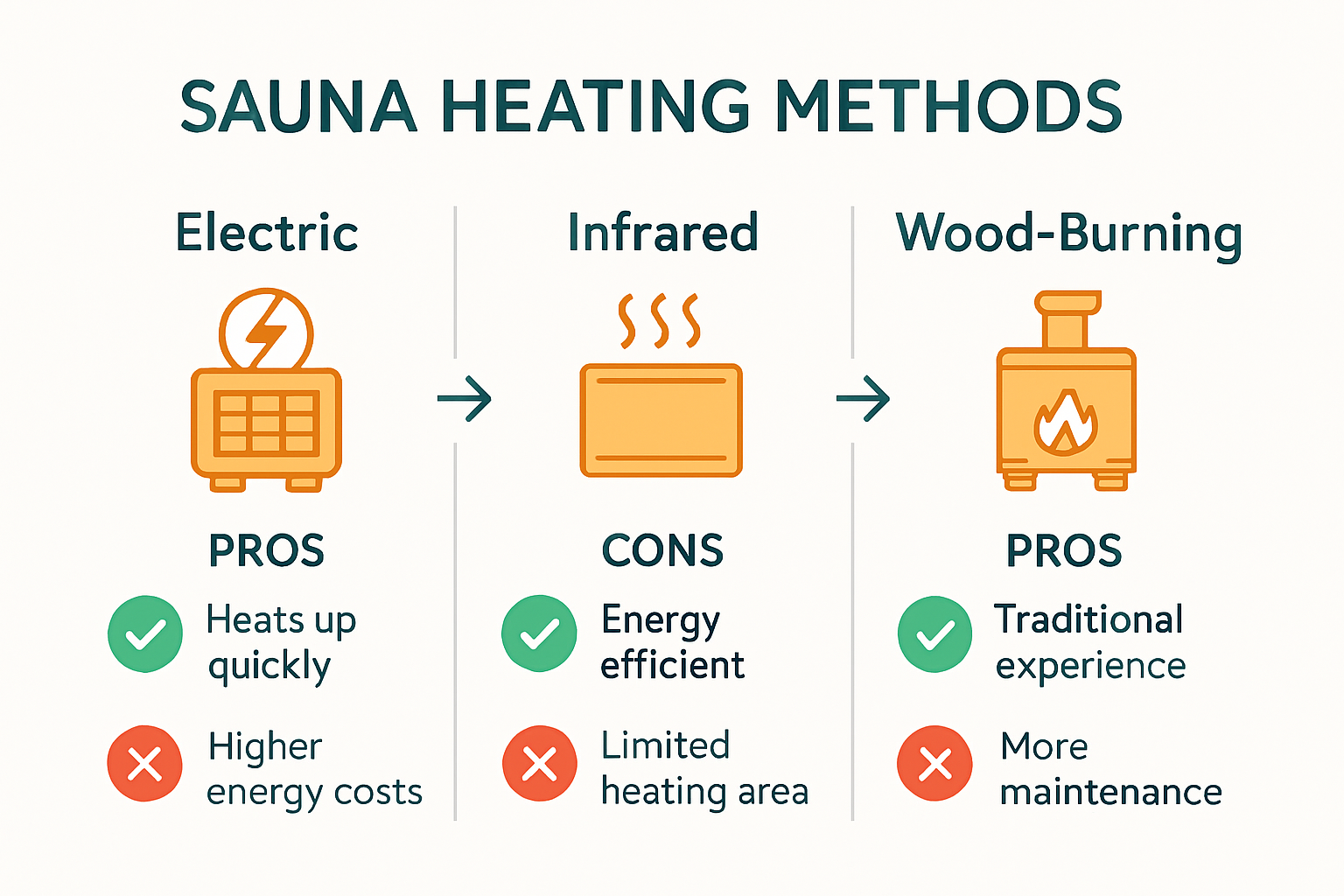
Sauna Heating Methods: Your 2025 Guide to the Best Sauna
 Sauna heating methods can dramatically shape your relaxation and wellness experience. Each method—whether electric, infrared, or wood-fired—carries distinct characteristics that impact how warmth envelops you. But here’s a surprising twist: the heating method isn’t just about comfort. Research shows that regular sauna use can improve cardiovascular health and enhance detoxification processes. Choosing the right sauna can not only elevate your relaxation but also boost your overall well-being. Let’s explore the unique benefits each heating method offers.
Sauna heating methods can dramatically shape your relaxation and wellness experience. Each method—whether electric, infrared, or wood-fired—carries distinct characteristics that impact how warmth envelops you. But here’s a surprising twist: the heating method isn’t just about comfort. Research shows that regular sauna use can improve cardiovascular health and enhance detoxification processes. Choosing the right sauna can not only elevate your relaxation but also boost your overall well-being. Let’s explore the unique benefits each heating method offers.
Table of Contents
- Understanding Different Sauna Heating Methods
- How Electric Sauna Heaters Work
- Infrared Sauna Heating Explained
- Benefits Of Woodburning Sauna Heaters
- Choosing Your Ideal Sauna Heating Method
Quick Summary
| Takeaway | Explanation |
|---|---|
| Understanding sauna heating methods is crucial for optimal experience | Each heating approach, whether electric, infrared, or wood-fired, has unique characteristics affecting temperature, energy consumption, and user experience. |
| Electric heaters offer modern convenience | They heat up quickly, require minimal maintenance, and provide precise temperature control, making them user-friendly for wellness spaces. |
| Infrared technology directly targets body tissues | This method provides therapeutic warmth at lower temperatures, enhancing energy efficiency and deeper tissue penetration for health benefits. |
| Wood-burning heaters connect users to tradition | They create an authentic sauna experience with sensory immersion, enriched atmosphere, and potential economic and environmental benefits through the use of local wood. |
| Choosing the right method hinges on personal needs | Evaluate personal wellness objectives, practical installation factors, and technology-specific performance metrics to find the ideal sauna heating solution. |
Understanding Different Sauna Heating Methods
Sauna heating methods play a crucial role in determining the overall sauna experience, comfort, and efficiency. Each heating approach offers unique characteristics that impact temperature, energy consumption, and the fundamental warmth delivery mechanism. Understanding these methods helps enthusiasts and homeowners select the most appropriate system for their specific needs and preferences.
Electric Heaters: The Modern Convenience
Electric sauna heaters represent the most popular and user-friendly heating method in contemporary wellness spaces. These heaters provide rapid heat generation, typically reaching optimal temperatures within 30-40 minutes. Home Depth Research confirms that electric heaters offer exceptional convenience, requiring minimal maintenance and providing precise temperature control.
Key advantages of electric heaters include:
- Quick heat-up times compared to traditional alternatives
- Simple installation process
- Consistent and predictable performance
- Easy digital temperature management
The electrical heating elements warm rocks or ceramic surfaces, creating radiant heat that fills the sauna space. This method ensures uniform heat distribution and allows users to control humidity by pouring water over heated stones, mimicking traditional sauna experiences.
Infrared and Alternative Heating Technologies
Infrared sauna heating represents a revolutionary approach that fundamentally differs from traditional methods. Unlike conventional heaters that warm the surrounding air, infrared systems directly target the human body. The Sauna Heater Academy explains that these heaters penetrate soft tissue, providing therapeutic warmth at lower ambient temperatures.
This innovative technology offers several unique benefits:
- Enhanced energy efficiency
- Lower operational temperatures
- Deeper tissue penetration
- Adaptability for smaller spaces
Additionally, less common heating methods like gas-powered systems provide alternative options for specific contexts. While requiring professional installation, gas heaters can be highly efficient when natural gas or propane infrastructure exists.
Wood-Fired Traditions: Classic Sauna Heating
Wood-burning sauna heaters represent the most traditional heating method, deeply rooted in Finnish cultural practices. These heaters require more manual effort and maintenance but offer an authentic, immersive experience. Typical wood-fired systems take 45-60 minutes to reach optimal temperatures and demand regular ash and chimney maintenance.
The appeal of wood-fired heaters lies in their:
- Authentic sensory experience
- Rich, traditional ambiance
- Potential for outdoor installations
- Connection to historical sauna practices
Wood-fired systems engage multiple senses, with crackling sounds and natural heat generation creating a more ritualistic sauna experience. While less convenient than electric alternatives, they remain cherished by sauna purists and those seeking a more traditional approach.
Choosing the right sauna heating method depends on individual preferences, space constraints, energy availability, and desired experience. Each technology offers distinct advantages, ensuring that modern wellness enthusiasts can find a heating solution perfectly aligned with their needs.
How Electric Sauna Heaters Work
Electric sauna heaters represent a sophisticated heating technology that transforms electrical energy into radiant heat, creating the immersive warmth essential to the sauna experience. Understanding their intricate operational mechanics helps users appreciate the engineering behind these wellness devices and make informed installation decisions.

Electrical Configuration and Power Dynamics
The core functionality of electric sauna heaters revolves around their precise electrical specifications. Redwood Outdoors notes that these devices typically require specialized electrical configurations, with power ratings ranging from 4.8 to 15 kW. Most models operate on 240V or 208V electrical systems, necessitating specific circuit configurations and professional installation.
Key electrical considerations include:
- Voltage requirements matching home electrical infrastructure
- Appropriate two-pole circuit breaker ratings (typically 30-amp)
- Professional electrical assessment before installation
- Compatibility with existing home electrical systems
The power rating directly influences the heater’s capacity to warm different sauna sizes, with higher kilowatt ratings accommodating larger spaces more effectively. This precise power management ensures consistent, reliable heat generation across various sauna dimensions.
Heating Element and Stone Interaction
The magic of electric sauna heaters happens through a sophisticated interaction between heating elements and specially selected stones. HUUM Sauna demonstrates that modern heaters can accommodate substantial stone volumes, with some models holding up to 250 kg (551 lb) of carefully selected rocks.
The heating process involves multiple critical stages:
- Electrical current passes through resistance-based heating elements
- Heating elements warm surrounding ceramic or metal surfaces
- Stones absorb and radiate heat throughout the sauna space
- Users can control humidity by introducing water to heated stones
This stone-based heat transfer mechanism creates a more natural, penetrating warmth compared to direct air heating. The stones act as thermal reservoirs, storing and slowly releasing heat, which provides a more consistent and comfortable sauna environment.
Temperature Control and Safety Mechanisms
Modern electric sauna heaters incorporate advanced temperature regulation and safety technologies. Digital controllers allow precise temperature management, typically ranging from 100°F to 200°F, with built-in safety features preventing overheating and electrical complications.
Critical safety features include:
- Automatic shut-off mechanisms
- Temperature limit sensors
- Thermal protection circuits
- Robust electrical insulation
These technological safeguards ensure that electric sauna heaters deliver a safe, controlled heating experience. The integration of microprocessor-based controls allows users to customize their sauna sessions with unprecedented precision, transforming a traditional heat experience into a personalized wellness ritual.
The evolution of electric sauna heaters represents a remarkable intersection of electrical engineering, thermal physics, and wellness design. By understanding their operational principles, users can appreciate the sophisticated technology delivering their therapeutic heat experience.
Infrared Sauna Heating Explained
Infrared sauna heating represents a groundbreaking approach to wellness technology, fundamentally transforming how heat interacts with the human body. Unlike traditional sauna methods that warm the surrounding air, infrared systems utilize electromagnetic radiation to directly target body tissues, creating a unique therapeutic experience.
The Science of Infrared Heat Transmission
Infrared heating operates through electromagnetic waves that penetrate soft tissue, delivering warmth directly to the body’s core. Mayo Clinic explains that these specialized waves generate heat within the body itself, enabling effective sweating and physiological responses at significantly lower ambient temperatures compared to traditional saunas.
The infrared spectrum is categorized into three primary wavelengths:
- Near-infrared waves with shortest penetration depth
- Mid-infrared waves providing moderate tissue interaction
- Far-infrared waves offering deepest tissue penetration
Each wavelength interacts differently with human tissue, creating nuanced therapeutic potential. Remarkably, research indicates that up to 93% of far-infrared waves can be absorbed by human skin when properly configured, maximizing potential health benefits.
Physiological Responses and Health Implications
Clinical research reveals fascinating insights into infrared sauna’s health potential. National Institutes of Health Studies demonstrate that regular infrared therapy can produce measurable physiological changes, including reductions in brain natriuretic peptide (BNP) levels among heart failure patients, suggesting significant cardiovascular benefits.
Key physiological responses include:
- Enhanced cellular metabolism
- Improved circulation
- Accelerated toxin elimination through concentrated sweating
- Potential reduction of inflammation markers
- Stimulation of cellular repair mechanisms
The molecular vibrations induced by infrared waves trigger complex biochemical responses, transforming heat exposure from a simple warming experience into a sophisticated therapeutic intervention.
Technology and Design Considerations
Modern infrared saunas incorporate advanced technological designs to optimize heat transmission and user experience. Specialized ceramic or carbon-based emitters carefully calibrate electromagnetic wave emissions, ensuring consistent, controlled therapeutic heat delivery.
Design innovations address several critical considerations:
- Precise wavelength management
- Energy efficiency
- Uniform heat distribution
- User comfort and safety
- Compact installation possibilities
These technological refinements distinguish infrared systems from traditional heating methods, offering a more targeted, efficient wellness solution. By directly engaging body tissues, infrared saunas provide a nuanced approach to heat therapy that transcends conventional sauna experiences.
The ongoing evolution of infrared heating technology represents an exciting intersection of medical research, electromagnetic physics, and holistic wellness design. As understanding deepens, infrared saunas continue to emerge as a sophisticated, scientifically-grounded approach to personal health and relaxation.
Benefits of Wood-Burning Sauna Heaters
Wood-burning sauna heaters represent more than just a heating method; they embody a centuries-old tradition of wellness, connecting users to a deeply authentic thermal experience. These traditional heaters offer a unique combination of sensory engagement, natural heat generation, and cultural heritage that distinguishes them from modern electrical alternatives.
Authentic Thermal Experience and Sensory Immersion
Home Depth Research highlights that wood-fired saunas provide a multisensory environment that transcends mere heat generation. The experience encompasses more than temperature, engaging multiple senses through the subtle nuances of natural heating.
Unique sensory characteristics include:
- Crackling wood sounds creating a rhythmic background
- Soft, undulating heat waves
- Natural wood aroma
- Dim, atmospheric lighting
- Potential for aromatherapeutic experiences with scented woods
The organic heat distribution differs significantly from uniform electric heaters. Wood-burning systems generate more variable, softer heat waves that penetrate differently, creating a more dynamic and responsive thermal environment. This natural variation mimics traditional Finnish sauna practices, where heat is experienced as a living, breathing phenomenon.
Economic and Environmental Considerations
Wood-burning sauna heaters offer compelling economic advantages, particularly in regions with abundant wood resources. Home Depth Research indicates these heaters can substantially reduce operational costs compared to electric alternatives, especially when local wood supplies are readily available.
Significant economic benefits include:
- Lower long-term energy expenses
- Reduced dependency on electrical infrastructure
- Potential for using renewable wood resources
- Independence from electrical grid fluctuations
- Opportunity to utilize locally sourced firewood
Environmentally conscious users appreciate wood-burning heaters’ potential for sustainable energy use. By utilizing responsibly harvested wood, these systems can represent a more carbon-neutral heating approach compared to electricity generated from fossil fuel sources.
Cultural Heritage and Therapeutic Dimensions
Beyond practical considerations, wood-burning sauna heaters carry profound cultural significance. They represent a direct connection to traditional wellness practices, particularly in Nordic cultures where saunas are integral to social and personal well-being.
Therapeutic and cultural dimensions include:
- Preservation of traditional heating methods
- Enhanced mind-body connection
- Ritualistic approach to personal wellness
- Deeper appreciation for natural heating technologies
- Connection to historical sauna practices
The manual process of preparing and maintaining a wood-fire introduces a meditative element to the sauna experience. Selecting wood, building the fire, and managing heat become part of a holistic wellness ritual that extends beyond mere temperature regulation.
Wood-burning sauna heaters represent more than a heating technology; they are a bridge between historical wellness practices and contemporary health approaches. By embracing these traditional systems, users gain not just heat, but a rich, multidimensional thermal experience that engages body, mind, and cultural heritage.
Choosing Your Ideal Sauna Heating Method
 Selecting the right sauna heating method represents a nuanced decision that balances personal preferences, practical considerations, and wellness goals. Each heating technology offers distinct advantages, making the selection process both exciting and complex for potential sauna enthusiasts.
Selecting the right sauna heating method represents a nuanced decision that balances personal preferences, practical considerations, and wellness goals. Each heating technology offers distinct advantages, making the selection process both exciting and complex for potential sauna enthusiasts.
Evaluating Personal Wellness Objectives
Home Depth Research suggests that understanding individual wellness goals is the critical first step in selecting an appropriate sauna heating method. Different technologies deliver varied therapeutic experiences, making alignment with personal health objectives paramount.
Key wellness considerations include:
- Detoxification intensity desired
- Cardiovascular health improvement goals
- Muscle recovery and relaxation needs
- Stress reduction preferences
- Chronic condition management requirements
Infrared systems excel in targeted tissue penetration, electric heaters provide consistent environmental control, and wood-burning heaters offer a holistic sensory experience. The ideal choice depends on matching technological capabilities with specific wellness outcomes.
Practical Infrastructure And Installation Factors
Beyond wellness goals, practical considerations play a crucial role in heating method selection. QCA Spas emphasizes the importance of evaluating home infrastructure, budget constraints, and long-term maintenance requirements.
Critical practical factors include:
- Initial equipment cost
- Electrical system compatibility
- Available installation space
- Maintenance complexity
- Energy consumption patterns
- Local climate and environmental conditions
Carbon infrared panels offer superior energy efficiency and lower electromagnetic field (EMF) emissions, making them attractive for users prioritizing technological sophistication. Electric heaters provide straightforward installation, while wood-burning systems demand more manual intervention but offer potential long-term cost savings.
Technology-Specific Performance Metrics
Advanced sauna enthusiasts should consider nuanced performance characteristics that differentiate heating technologies. High-quality far-infrared heating elements with substantial glass content demonstrate superior heat distribution and longevity compared to traditional designs.
Performance evaluation metrics include:
- Heat penetration depth
- Energy conversion efficiency
- Temperature uniformity
- Session duration capabilities
- Electromagnetic field (EMF) emissions
- Technological lifespan
Cylinder-type steel and tubular ceramic heaters typically generate higher surface temperatures but exhibit shorter operational lifespans. Solid ceramic panels with high glass content provide more consistent, penetrative infrared radiation, representing a sophisticated technological approach.
The journey to selecting an ideal sauna heating method transcends mere temperature generation. It represents a personalized wellness strategy integrating technological innovation, individual health objectives, and practical considerations. By carefully analyzing these multifaceted dimensions, users can transform their sauna experience from a simple heat exposure to a targeted, refined wellness intervention.
Frequently Asked Questions
What are the main sauna heating methods?
Sauna heating methods include electric heaters, infrared systems, and wood-burning heaters. Each method has unique features, energy consumption patterns, and user experiences, catering to different wellness needs.
How do electric sauna heaters work?
Electric sauna heaters heat up quickly using electrical energy. They utilize resistance-based heating elements that warm rocks or other materials, creating radiant heat that fills the sauna. These systems also offer precise temperature control and require minimal maintenance.
What are the health benefits of using an infrared sauna?
Infrared saunas provide therapeutic warmth that penetrates deep into body tissues. They can enhance detoxification, improve circulation, and promote better cardiovascular health, making them an effective tool for relaxation and physical recovery.
Why should I choose a wood-burning sauna heater?
Wood-burning sauna heaters create an authentic sauna experience by engaging all the senses. They produce a rich, natural heat and aroma, connecting users to traditional sauna practices. Additionally, they can be more economical in areas with abundant wood resources.
Elevate Your Wellness Journey with Best Life Sauna
Your path to relaxation and health starts with understanding the right sauna heating method for your needs. Whether it’s the modern convenience of electric heaters, the therapeutic benefits of infrared, or the authentic experience of wood-fired saunas, each option offers something unique to enhance your wellness journey. But the real challenge is finding the perfect sauna to fit your lifestyle and wellness goals—not to mention the added benefits like stress relief, improved blood circulation, and enhanced skin health.
Imagine stepping into a sauna that’s perfectly tailored to your personal health objectives. With Best Life Sauna, you don’t just imagine it—you can experience it! Our extensive collection features infrared, traditional, and outdoor saunas designed to meet diverse wellness needs along with essential accessories. Plus, enjoy the peace of mind with our price match guarantee and free shipping on orders over $200.

Don’t wait to transform your space into a sanctuary. Explore our wide range of saunas today at Best Life Sauna and take the first step towards a healthier and happier you! Embrace the benefits of sauna therapy and UP your wellness game NOW!
Recommended Articles
- Embrace Wellness: Paying for Your Sauna with FLEX at Best Life Sauna Best Life Sauna - Premium Saunas for WellnessAmerican ExpressApple PayDiners ClubDiscoverGoogle PayMastercardPayPalShop PayVisa
- 2025 Aesthetic Sauna Designs: Stunning Ideas & Trends – Best Life Sauna
- Ultimate Guide to Sauna Investments 2025: Benefits & ROI – Best Life Sauna
- Infrared Sauna Safety 2025: Essential Wellness Guide – Best Life Sauna
- The Cardiovascular Benefits of Sauna Therapy – Best Life SaunaBest Life Sauna - Premium Saunas for WellnessAmerican ExpressApple PayDiners ClubDiscoverGoogle PayMastercardPayPalShop PayVisa

